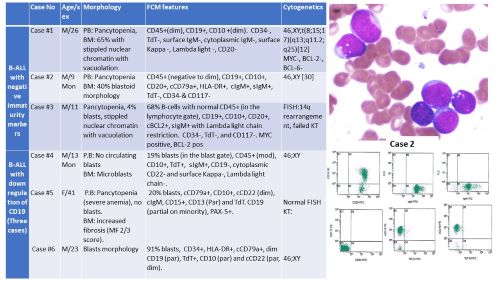
Contributions
Abstract: PB1377
Type: Publication Only
Session title: Acute lymphoblastic leukemia - Clinical
Background
B-acute lymphoblastic leukemia/lymphoblastic lymphoma is a hematologic neoplasm of precursor lymphoid B-cells. The lymphoblasts are almost always positive for the B-cell markers and TdT in most cases, whereas CD20 and CD34 expression is variable. B-ALL/LBL demarcated by expression of at least one surrogate immaturity marker and typically lack features indicating mature phenotype.
Aims
The objective of this review is to recap B-ALL/LBL with unusual clinicopathologic features diagnosed in our center.
Methods
We reviewed patients with B-ALL/LBL diagnosed in Hamad medical corporation according to WHO 2016 diagnostic criteria (2011-2019). We included B-ALL with one or more unusual features including: atypical clinical presentation, rare morphology, unusual cytogenetics, rare immunophenotype and phenotype overlapping with mature B-cell neoplasms. The relevant data correlated with the disease course, and patients’ response. The relevant and most recent literature was reviewed.
Results
15 patients with unusual challenging clinicopathologic features were detected. Rare cases showed lack of expression of immaturity markers in an otherwise typical ALL (three patients), including two patients of pediatric age group, one (# case 2) received ALL BFM 2009 protocol with good response and negative MRD. The second child (case #3), had some features overlapping with high grade B-cell lymphomas a very rare diagnosis in pediatric age group. The patients were treated according to Inter-B-NHL Ritux 2010 IGR 2009 and showed complete remission.
Few B-ALL cases showed asynchronous expression of immaturity marker (TdT) associated with markers indicating mature phenotype (mature B- ALL) (3 patients); including two patients with t(9;22)(q32;q11). Our cohort included three exceptional cases that showed loss/down regulation of pan B-markers CD19 and CD22. A single case showed rare coexistence of IGH and MYC rearrangements in de novo precursor B-ALL (double hit B-ALL). Two cases of B-ALL showed positivity for MPO by IHC in an otherwise typical B-ALL immunophenotype.
Unusual morphologic features detected in B-ALL, included increased fibrosis, BM necrosis, abnormal eosinophilia, lymphoblasts with granulation/ or pseudo Chediak-Higashi globule, Cup-like blasts or increased megakaryocytes (at presentation).

Conclusion
The complexity and variety of cases presented in this review emphasize the importance of multi-parametric approach and its value in the proper categorization of patients with B-ALL/LBL. Few cases of precursor B-ALL patients show clearly overlapping feature with mature B-cell neoplasms, however, currently no definitive WHO category that can adopt such B- neoplasms and no standard treatment protocols. In similar cases the expression of TdT was given the upper hand over other features. In pediatric age group, cases that lack expression of immaturity markers, were best classified as precursor B-ALL, being the commonest in this age group, and supported by dim CD45 expression, blastoid morphology and/or lack of surface immunoglobulin expression.
Pan B-cell markers is rarely lost in denovo B-lymphoid neoplasms. Reporting B-ALL with such peculiar features would probably draw attention to B-ALL unusual/overlapping features and experiences regarding treatment and disease outcome.
Keyword(s): ALL, B cell acute lymphoblastic leukemia
Abstract: PB1377
Type: Publication Only
Session title: Acute lymphoblastic leukemia - Clinical
Background
B-acute lymphoblastic leukemia/lymphoblastic lymphoma is a hematologic neoplasm of precursor lymphoid B-cells. The lymphoblasts are almost always positive for the B-cell markers and TdT in most cases, whereas CD20 and CD34 expression is variable. B-ALL/LBL demarcated by expression of at least one surrogate immaturity marker and typically lack features indicating mature phenotype.
Aims
The objective of this review is to recap B-ALL/LBL with unusual clinicopathologic features diagnosed in our center.
Methods
We reviewed patients with B-ALL/LBL diagnosed in Hamad medical corporation according to WHO 2016 diagnostic criteria (2011-2019). We included B-ALL with one or more unusual features including: atypical clinical presentation, rare morphology, unusual cytogenetics, rare immunophenotype and phenotype overlapping with mature B-cell neoplasms. The relevant data correlated with the disease course, and patients’ response. The relevant and most recent literature was reviewed.
Results
15 patients with unusual challenging clinicopathologic features were detected. Rare cases showed lack of expression of immaturity markers in an otherwise typical ALL (three patients), including two patients of pediatric age group, one (# case 2) received ALL BFM 2009 protocol with good response and negative MRD. The second child (case #3), had some features overlapping with high grade B-cell lymphomas a very rare diagnosis in pediatric age group. The patients were treated according to Inter-B-NHL Ritux 2010 IGR 2009 and showed complete remission.
Few B-ALL cases showed asynchronous expression of immaturity marker (TdT) associated with markers indicating mature phenotype (mature B- ALL) (3 patients); including two patients with t(9;22)(q32;q11). Our cohort included three exceptional cases that showed loss/down regulation of pan B-markers CD19 and CD22. A single case showed rare coexistence of IGH and MYC rearrangements in de novo precursor B-ALL (double hit B-ALL). Two cases of B-ALL showed positivity for MPO by IHC in an otherwise typical B-ALL immunophenotype.
Unusual morphologic features detected in B-ALL, included increased fibrosis, BM necrosis, abnormal eosinophilia, lymphoblasts with granulation/ or pseudo Chediak-Higashi globule, Cup-like blasts or increased megakaryocytes (at presentation).

Conclusion
The complexity and variety of cases presented in this review emphasize the importance of multi-parametric approach and its value in the proper categorization of patients with B-ALL/LBL. Few cases of precursor B-ALL patients show clearly overlapping feature with mature B-cell neoplasms, however, currently no definitive WHO category that can adopt such B- neoplasms and no standard treatment protocols. In similar cases the expression of TdT was given the upper hand over other features. In pediatric age group, cases that lack expression of immaturity markers, were best classified as precursor B-ALL, being the commonest in this age group, and supported by dim CD45 expression, blastoid morphology and/or lack of surface immunoglobulin expression.
Pan B-cell markers is rarely lost in denovo B-lymphoid neoplasms. Reporting B-ALL with such peculiar features would probably draw attention to B-ALL unusual/overlapping features and experiences regarding treatment and disease outcome.
Keyword(s): ALL, B cell acute lymphoblastic leukemia


